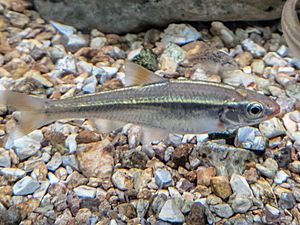Bleeding shiner facts for kids
Quick facts for kids Bleeding shiner |
|
|---|---|
 |
|
| Conservation status | |
| Scientific classification | |
| Synonyms | |
|
Notropis zonatus |
The bleeding shiner (Luxilus zonatus) is a freshwater ray-finned minnow in the family Cyprinidae, which includes carps and minnows. It occurs in tributaries of Ozark-draining tributaries of the Missouri, and Mississippi rivers in southern Missouri and northeastern Arkansas. Its preferred habitat is rocky and sandy pools and runs of headwaters, creeks and small rivers.
Contents
Taxonomy
Description
The bleeding shiner has an olive brown back with a broad dark stripe along its midline. It has metallic sides and has two black stripes that are separated with a golden stripe. One of these black strips extends to the tip of the snout, while another less obvious black stripe parallels it. The gill opening has a crescent-bar shape and the fish has a silvery white underside.
Breeding males have bright red markings on their head, body, and fins, and the rest of their markings appear darker.
The bleeding shiner has an average total length of about 4 in (10 cm) and has a maximum total length of 4.75 in (12 cm).
Distribution and habitat
The bleeding shiner occurs in many rivers of the Ozark Plateau, including the St. Francis, Black, Little, Meramec, Osage, Big Piney, and Gasconade Rivers.
Bleeding shiners prefer clear, gravel-bottomed streams and rivers. They have (very rarely) been found in streams with beds of mud, however.
Diet
The bleeding shiner feeds upon insects and small invertebrates that can be found upon the water's surface or that are being carried by the current.
It is thought that the bleeding shiner searches for food primarily by sight because of its large eyes.
Behaviors
Reproduction
Spawning usually occurs over gravel nests and pits that have been made by other fish, namely those of other minnows. Anywhere from a few to a hundred gather in these locations while spawning.
Life history
Bleeding shiners rarely live through three summers.
Human interest
Conservation
Trends over the last three generations (10 years) indicates that the population may be slowly declining. This is uncertain, however. It is abundant throughout its range.
Bleeding shiners have been known to invade some areas, such as the Clear Creek system.
See also
 In Spanish: Luxilus zonatus para niños
In Spanish: Luxilus zonatus para niños


